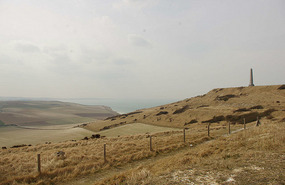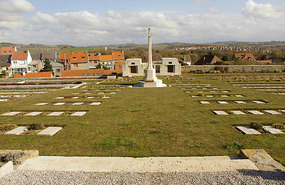We had a very relaxing morning in camp before setting to out towards Calais. We hopped off the auto-route near Calais and took the scenic route from there to Wimereux. The road wound its way along the coastline, offering plenty of panoramic view points. The cliffs, small towns and the farmland that ran almost to the edge of the limestone cliffs reminded us of the cliffs on Whidbey Island, Washington. Our first stop along this scenic drive was at Cap Blanc Nez. There was a memorial at the tip of the cape to commemorate all those that had protected the vital link over the channel between Dover and Calais during WWI. These vantage points along the Opal coast were strategic not only in WWI, but also in WWII.
Today's viewpoints are constructed on top of WWII bunkers, which were German fortifications that formed part of their "Atlantic Wall". From one of the viewpoints, we could see a nearby man-made lake. An info panel explained that this “lake” was created as a by-product of the slurry from the digging of the Chunnel and the top of the German bunker was sometimes visible when the water level dropped. These bunkers and gun emplacements were strategically placed to defend the coastline from invasion and we learned that the guns here could fire one tonne shells at a range of 40 km, enough to span the channel and reach the cities of Kent. The bunkers were also the site of radars that could detect aeroplane formations all the way in Kent and thus warn the Germans of an attack. On our way back from the viewpoint, we were looking directly across the road onto the hills on the other side where we could see lots of craters undoubtedly a result of the war.
We got back in the van and headed a short distance along the coast. We walked down to the beach, at the base of the limestone cliffs below Cap Blanc Nez. We took a few moments to look around and noticed that there was a large bunker situated on the beach, just beside where we had descended. Our final stop along our scenic drive was at Cap Gris Nez where we were afforded panoramic views back along the coast towards Calais. Unfortunately, the views weren’t spectacular because it was very hazy out. We walked around the top of the cliff to a couple of the viewpoints and then headed to our next campsite in Wimereux.
The next morning, we woke up to rain and had a lazy morning in camp. We caught up on some laundry and dishes while we waited for an “interview” call from our insurers at noon. Megs took the call at noon, which only lasted about ten minutes, and during which they just seemed to confirm the details we had submitted in writing. It was still going to take them a few days to process the claim so we were definitely frustrated because it had been nearly two weeks now. We had French toast in the van and in the late afternoon, the weather cleared up and the sun was out in full force. We decided to walk into Wimereux, a couple kilometers away, and look for the communal cemetery. The cemetery was confusingly signed (marked as communal, British, East & Ancient) and just as we were about to give up, we spotted the CWGC sign. We were here looking for the grave for Lytton Wilde, Meghan’s great-great-uncle.
He died of mustard gas poisoning in the First World War. We were surprised to find a WWI cemetery this far away from the front line and after reading the info panel, we learned that Wimereux and Boulougne-s-Mer formed an important hospital centre from 1914 to 1918. The medical units at Wimereux used the existing communal cemetery, with the south-eastern half set aside for the Commonwealth graves. We noticed that the grave stones here were placed flat in the ground and later learned that this was because of the sandy nature of the soil. It also happened that John McCrae was buried in this cemetery and we located his grave stone, too, only a few steps away from Lytton Wilde’s. We wondered if perhaps if Wilde and McCrae had crossed paths during the war. We soon left the cemetery and walked back to camp, stopping along the way to pick up a chausson. It was actually warm enough for us to not have our gloves and toques on and we hoped that this was going to be a more permanent trend in the days to come.
Côte d’Opal
Tuesday, April 09, 2013
 Wimereux, Nord-Pas-de-Calais, France
Wimereux, Nord-Pas-de-Calais, France
Other Entries
-
107Marquessac Gardens
Mar 0337 days prior Vezac, Francephoto_camera29videocam 0comment 2
Vezac, Francephoto_camera29videocam 0comment 2 -
108Three "Plus Beaux Villages"
Mar 0436 days prior Domme, Francephoto_camera18videocam 0comment 0
Domme, Francephoto_camera18videocam 0comment 0 -
109A day for chores
Mar 0535 days prior Sarlat-la-Canéda, Francephoto_camera13videocam 0comment 1
Sarlat-la-Canéda, Francephoto_camera13videocam 0comment 1 -
110Relaxing in the Dordogne
Mar 0931 days prior Beynac-et-Cazenac, Francephoto_camera54videocam 0comment 2
Beynac-et-Cazenac, Francephoto_camera54videocam 0comment 2 -
111Prehistoric Art in the Dordogne
Mar 1129 days prior Les Eyzies-de-Tayac, Francephoto_camera15videocam 0comment 1
Les Eyzies-de-Tayac, Francephoto_camera15videocam 0comment 1 -
112Market Day in Brantome
Mar 1525 days prior Brantome, Francephoto_camera23videocam 0comment 1
Brantome, Francephoto_camera23videocam 0comment 1 -
113Chateau de Fontainebleau
Mar 1723 days prior Fontainebleau, Francephoto_camera53videocam 0comment 0
Fontainebleau, Francephoto_camera53videocam 0comment 0 -
114Chateau de Vaux-le-Vicomte
Mar 1921 days prior Vaux-le-Vicomte, Francephoto_camera51videocam 0comment 0
Vaux-le-Vicomte, Francephoto_camera51videocam 0comment 0 -
115Paris
Mar 2713 days prior Paris, Francephoto_camera139videocam 2comment 2
Paris, Francephoto_camera139videocam 2comment 2 -
116WWI Museum in Peronne
Mar 2812 days prior Peronne, Francephoto_camera41videocam 0comment 1
Peronne, Francephoto_camera41videocam 0comment 1 -
117"Van"dalism
Mar 2911 days prior Peronne, Francephoto_camera3videocam 0comment 0
Peronne, Francephoto_camera3videocam 0comment 0 -
118Memorials of the Somme
Mar 319 days prior Albert, Francephoto_camera29videocam 0comment 0
Albert, Francephoto_camera29videocam 0comment 0 -
119Vimy Ridge
Apr 018 days prior Vimy, Francephoto_camera26videocam 0comment 0
Vimy, Francephoto_camera26videocam 0comment 0 -
120Ypres and WWI Memorials
Apr 036 days prior Ypres, Belgiumphoto_camera57videocam 0comment 0
Ypres, Belgiumphoto_camera57videocam 0comment 0 -
121Belgian Treats in Bruges
Apr 054 days prior Brugge, Belgiumphoto_camera55videocam 0comment 0
Brugge, Belgiumphoto_camera55videocam 0comment 0 -
122More Belgian Treats in Ghent
Apr 063 days prior Ghent, Belgiumphoto_camera28videocam 0comment 1
Ghent, Belgiumphoto_camera28videocam 0comment 1 -
123Moules in Dunkerque
Apr 072 days prior Dunkerque, Francephoto_camera11videocam 0comment 1
Dunkerque, Francephoto_camera11videocam 0comment 1 -
124Côte d’Opal
Apr 09 Wimereux, Francephoto_camera14videocam 0comment 1
Wimereux, Francephoto_camera14videocam 0comment 1 -
125Van repaired and a visit to Brighton
Apr 112 days later Brighton, United Kingdomphoto_camera16videocam 0comment 1
Brighton, United Kingdomphoto_camera16videocam 0comment 1 -
126Open Air Museum in Arnhem
Apr 145 days later Arnhem, Netherlandsphoto_camera55videocam 0comment 2
Arnhem, Netherlandsphoto_camera55videocam 0comment 2 -
127Amsterdam
Apr 178 days later Amsterdam, Netherlandsphoto_camera72videocam 0comment 2
Amsterdam, Netherlandsphoto_camera72videocam 0comment 2 -
128Aalsmeer Flower Auction
Apr 189 days later Aalsmeer, Netherlandsphoto_camera47videocam 3comment 0
Aalsmeer, Netherlandsphoto_camera47videocam 3comment 0 -
129Cheese Market in Alkmaar
Apr 1910 days later Alkmaar, Netherlandsphoto_camera62videocam 0comment 0
Alkmaar, Netherlandsphoto_camera62videocam 0comment 0 -
130The Historic Triangle
Apr 2011 days later Hoorn, Netherlandsphoto_camera81videocam 2comment 3
Hoorn, Netherlandsphoto_camera81videocam 2comment 3 -
131Fishing Village of Marken
Apr 2112 days later Marken, Netherlandsphoto_camera21videocam 0comment 1
Marken, Netherlandsphoto_camera21videocam 0comment 1 -
132Edam, Tulips & Windmills
Apr 2213 days later Lisse, Netherlandsphoto_camera49videocam 0comment 1
Lisse, Netherlandsphoto_camera49videocam 0comment 1 -
133Canal Boating on the Bourgogne
May 0122 days later Migennes, Francephoto_camera110videocam 5comment 3
Migennes, Francephoto_camera110videocam 5comment 3 -
134Trapped by the Floods
May 0425 days later Fleurey-sur-Ouche, Francephoto_camera48videocam 1comment 0
Fleurey-sur-Ouche, Francephoto_camera48videocam 1comment 0 -
135Canal Boating on the Lateral Canal to the Loire
May 0930 days later Briare, Francephoto_camera99videocam 3comment 4
Briare, Francephoto_camera99videocam 3comment 4 -
136Dinan
May 1334 days later Dinan, Francephoto_camera42videocam 0comment 1
Dinan, Francephoto_camera42videocam 0comment 1 -
137Coastal Walk & Saint Malo
May 1435 days later Saint-Malo, Francephoto_camera21videocam 0comment 0
Saint-Malo, Francephoto_camera21videocam 0comment 0 -
138Fort-la-Latte & Cap Frehel
May 1536 days later Fort-la-Latte, Francephoto_camera40videocam 0comment 0
Fort-la-Latte, Francephoto_camera40videocam 0comment 0 -
139Paimpol & the Sillon de Talbert
May 1637 days later Paimpol, Francephoto_camera24videocam 0comment 0
Paimpol, Francephoto_camera24videocam 0comment 0 -
140Île-de-Bréhat
May 1738 days later Île-de-Bréhat, Francephoto_camera74videocam 1comment 0
Île-de-Bréhat, Francephoto_camera74videocam 1comment 0 -
141Bird Spotting and the Pink Granite Coast
May 1839 days later Perros-Guirec, Francephoto_camera56videocam 1comment 0
Perros-Guirec, Francephoto_camera56videocam 1comment 0 -
142Crepes in Roscoff and the Keremma dunes
May 2041 days later Roscoff, Francephoto_camera46videocam 0comment 0
Roscoff, Francephoto_camera46videocam 0comment 0

 Wimereux, Nord-Pas-de-Calais, France
Wimereux, Nord-Pas-de-Calais, France

















2025-05-22